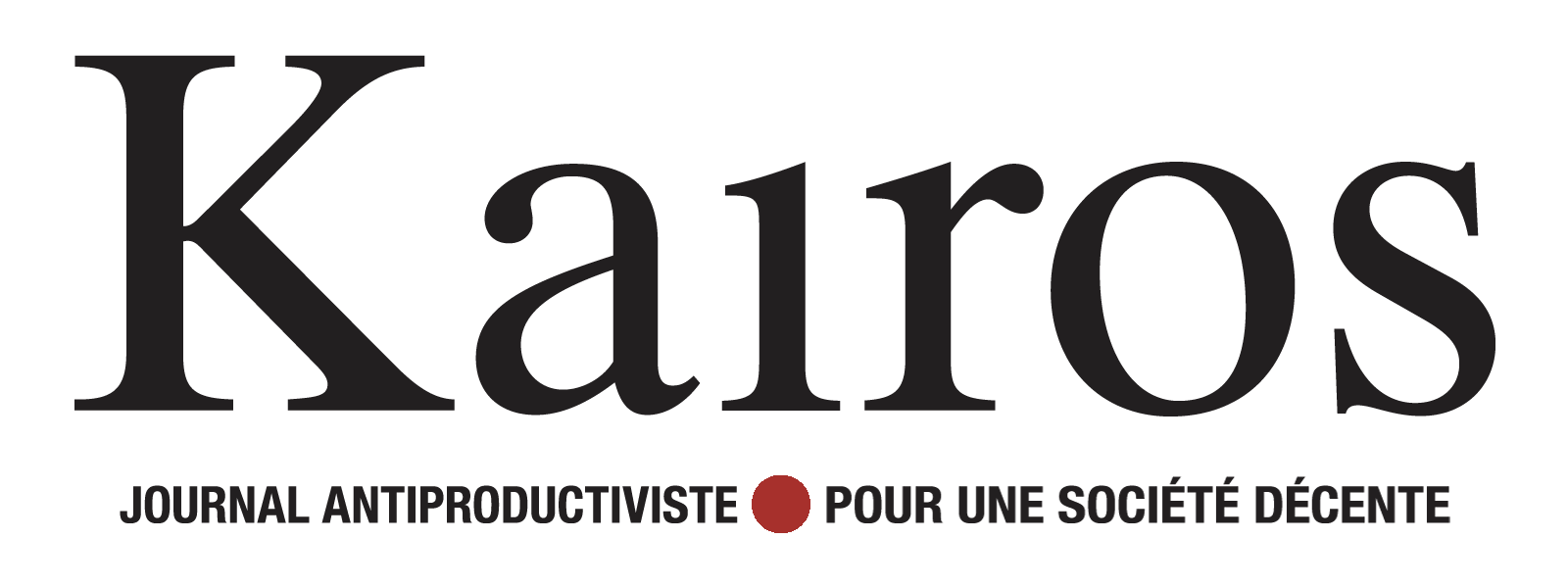Après une année de gestion de pandémie qui a fait couler beaucoup d’encre, le vaccin tant attendu et annoncé est enfin là. À noter que le terme « vaccin » a été utilisé plus au singulier qu’au pluriel, ce qui n’est pas sans évoquer le deus ex machina des tragédies grecques: une intervention divine qui dénoue soudainement une situation désespérée. Les défenseurs de la technologie (sous l’étendard du progressisme) saluent bien évidemment l’arrivée de la solution miracle qui mettrait un terme à l’épidémie qui secoue la planète. Tout écart à ce cadre de pensée suscite l’usage d’un vocabulaire à relent propagandiste : « conspirationniste », « covidiot » ou « rassuriste » (ce dernier étant particulièrement violent à mon sens, car il sous-entend que le simple fait de rassurer son entourage est déjà éthiquement questionnable; depuis quand est-il déplorable de simplement rassurer des personnes en détresse psychologique ?).
L’industrie pharmaceutique, dans sa globalité, nous propose quatre types de vaccins contre le SRAS-CoV‑2.
Deux sont basés sur des technologies « classiques » utilisées depuis près d’un siècle et sont composés de :
1) virus atténués (ex. d’entreprises : Sinopharm, Sinovac), vaccin polyclonal (c’est-à-dire ciblant plusieurs composantes du SRAS-CoV‑2).
2) fragments de virus (ex. d’entreprises : Novavax), vaccin monoclonal (ne ciblant qu’un seul constituant du virus).
Les deux autres sont construits avec de nouvelles technologies « géniques » et sont composés de :
3) matériel génétique viral sous forme d’ARN, encore jamais appliqué sur les humains (ex. d’entreprises : Pfizer/BioNTech, Moderna), vaccin monoclonal.
4) un vecteur viral qui délivre du matériel génétique (ARN) viral d’intérêt (dans ce cas, celui de SRAS-CoV‑2) (ex. d’entreprises : AstraZeneca/Oxford, Johnson & Johnson), vaccin monoclonal.
Tous ces vaccins ne se valent pas et les rejeter en bloc sans les considérer séparément serait tout aussi étroit d’esprit que de considérer la vaccination contre le COVID-19 comme un deus ex machina à notre pandémie (ou plutôt deus ex vaccina). Bien qu’issus de technologies différentes, ces vaccins présentent des points communs. Leur élaboration a été extrêmement rapide, sachant que le développement d’un nouveau vaccin peut prendre des années (parfois au-delà de 10 ans, selon l’OMS)(1). En effet, lors de la réalisation de nouveaux vaccins, une partie du temps est perdue dans l’attente de diverses autorisations, régulations et financements et une autre partie est consacrée au développement de la technologie vaccinale. Dans le cas du SRAS-CoV‑2, ces deux phases ont pu être raccourcies, car d’une part les délais administratifs habituels ont été accélérés et d’autre part les études sur ces nouvelles technologies avaient déjà débuté avant l’arrivée de la pandémie. Mais fabriquer des vaccins dans la précipitation n’est jamais idéal, surtout quand il s’agit d’évaluer leur efficacité et l’étendue des effets secondaires de nouvelles technologies. Ceci est d’autant plus vrai pour ce virus qui présente des particularités qui rendent la conception d’un vaccin compliquée.
Deux craintes principales: l’efficacité et les effets secondaires des vaccins
I. L’efficacité
L’efficacité vaccinale ne dépend pas uniquement de la biotechnologie, mais de la nature de la cible : le virus lui-même. S’il n’existe pas de vaccins durables contre les virus responsables des rhumes ou de la grippe, c’est notamment parce que ces virus évoluent rapidement. Ceci est typiquement le cas des virus à ARN (dont les coronavirus font partie). Outre les mutations (c’est-à-dire la transformation du code génétique par « erreur »), ils se recombinent également fréquemment (ce qui est l’équivalent « d’échanges » génétiques entre virus)(2). Si les coronavirus sont capables d’accomplir des «ping-pong entre espèces animales (y compris l’humain)»(3), c’est bien grâce à cette faculté de transformation.
Un vaccin monoclonal (qui ne cible donc qu’un seul élément du virus) n’aura très probablement qu’une efficacité éphémère, limitée dans le temps par l’apparition d’un variant quelconque du SRAS-CoV‑2. En revanche, un vaccin polyclonal offre aux vaccinés la possibilité de développer des défenses contre différentes parties du virus, permettant de diminuer le risque que le virus échappe (après évolution) à l’immunité collective.
Dans le cas des vaccins monoclonaux contre le SRAS-CoV‑2, la composante visée est la protéine « spike » (ces fameuses protéines de surface en forme de boutons que l’on représente à la surface du virus lorsqu’il est dessiné). Le choix stratégique de cette cible est basé sur sa nature stimulante de notre immunité. Or, cette protéine est utilisée par le virus pour reconnaître son hôte et est sujette aux mutations, dont plusieurs ont déjà été documentées(4). Ainsi, l’espoir d’éradiquer ce virus néglige les possibilités suivantes :
- la protéine spike du virus mute et le vaccin devient inefficace. Le nouveau variant est aussi dangereux que le précédent, voire pire ;
- la pression de sélection darwinienne favorise la transmission du virus par voie indépendante de la protéine spike (un mécanisme moins fréquent, mais documenté(5)) ;
- le virus se recombine avec un autre virus et change de manière à échapper au vaccin (un scénario d’autant plus dangereux s’il s’agit d’un autre coronavirus virus épidémique, comme le MERS-CoV(6)) ;
- le virus disparaît de l’hôte humain (scénario idéal) et se « réfugie » dans les réservoirs animaux, où ils continuent à évoluer. Le retour d’un variant échappant au vaccin ne serait ainsi pas exclu. À noter à ce titre qu’il est impossible d’éradiquer une zoonose (c’est-à-dire une infection partagée entre humain et autres animaux) à moins que tous les animaux-hôtes soit vaccinés ou éliminés.
L’industrie pharmaceutique propose évidemment une solution : celle de renouveler les vaccins et fournir les doses selon une stratégie vaccinale qui consiste à administrer un vaccin contre le SRAS-CoV‑2 plusieurs fois par an. Pour un prix de 20 euros la dose, deux fois par an pour un marché ciblant une grande partie de la population planétaire, cela est effectivement fort intéressant pour l’industrie et pour les fonds d’investissement boursiers. Il s’agit d’un marché renforcé par décision politique de 300 à 500 milliards d’euros par an avec des garanties financières négociées (entre autres avec l’Union Européenne(7)).
II. Les effets secondaires
L’inquiétude des effets secondaires et de la tolérance aux vaccins modernes (ceux à ARN) contre le COVID-19 est fréquemment écartée par les techno-progressistes résolus, qui se réfèrent aux essais cliniques. Tout en admettant qu’un essai clinique (comme celui de la firme Pfizer) effectué sur 38.000 personnes est prometteur et qu’il serait difficile d’exiger plus d’une entreprise, il est extrêmement peu probable que les résultats puissent être aussi encourageants une fois appliqués à des chiffres plus volumineux de plusieurs ordre de grandeur. Si le chiffre de 38.000 personnes peut sembler élevé, celui-ci ne pourra jamais englober une diversité des profils de santé équivalente à la population à qui est destiné le vaccin. L’épidémie étant planétaire et le pourcentage nécessaire pour l’acquisition d’une immunité collective étant situé entre, environ, 60–70% selon l’OMS(8), cela ferait une cible théorique d’environ cinq milliards de personnes, soit une population un million de fois plus nombreuse que dans l’essai de Pfizer (tout en admettant que le nombre réel de personnes vaccinées sera sans doute inférieur). Selon les données de Pfizer(9), 0.6% des sujets vaccinés ont présenté des « événements indésirables graves » (contre 0.5% dans le groupe placebo). Mais 0.1% d’effets secondaires pouvant mettre la vie en danger mis à l’échelle d’un milliard de personnes mettrait un million de vies en danger! Toute mesure préventive se doit de faire moins de mal que la pathologie en question. Or, la létalité de SRAS-CoV‑2 (qui oscille aux alentours de 0.2%(10)) est loin d’être comparable à celle des épidémies de peste ou de l’Ebola. Est-il ainsi justifiable de risquer tous ces événements indésirables graves?
Vu que la technologie de vaccin à ARN est nouvelle, il est impératif de la valider. Les vaccins classiques peuvent être certifiés très rapidement, car leurs technologies sont connues et ne posent ainsi aucun problème (c’est pour cela que deux vaccins anti-grippe peuvent être produits et certifiés par an). Pour les vaccins à ARN, certifier sans appliquer la même rigueur de base serait incorrect. Notons d’ailleurs que ceux qui se revendiquent du principe de précaution avec les gestes barrières et les masques sont soudainement absents du débat !
À la liste des préoccupations déjà citées peuvent également être ajoutées :
- l’inefficacité de tels nouveaux vaccins à vecteurs viraux chez les personnes qui auraient une immunité naturelle contre le vecteur lui-même (le vecteur est un virus humain « vide », rempli avec de l’ARN codant pour des antigènes de SRAS-CoV‑2). Ceci est un problème bénin, réel, mais dont personne ne semble se soucier (problème inexistant avec les vaccins classiques)
- Une éventuelle recombinaison de la construction vecteur/SRAS-CoV‑2 avec un/des virus naturel(s). Ceci est un problème beaucoup plus grave. Dans le milieu scientifique (et ceci devient un peu technique, mais peut intéresser certains lecteurs compétents dans le domaine), deux arguments sont opposés à cette préoccupation (i) des échanges de gènes ne se font qu’entre des virus du même type (entre des virus à ADN d’une part et des virus à ARN d’autre part, mais pas entre ces deux catégories) et (ii) tout événement catastrophique serait peu probable. Le premier argument est correct, mais des exemples d’échanges entre des virus à ARN et ADN existent et ne peuvent être ainsi négligés(11). La deuxième dialectique qui consiste à balayer les craintes sous prétexte que même si des risques existent, ils sont tellement improbables qu’ils peuvent être écartés, démontre l’insouciance des techno-progressistes face à des calculs de probabilités. Il suffit d’imaginer, par exemple, que seul un centième de la population mondiale serait vacciné au final, et ce, deux fois par an. Cela représenterait toujours des centaines de millions de doses par an, intégrant à des milliers/millions de nos cellules plusieurs particules virales vectrices du vaccin, tous potentiellement capables de se transformer… Il faudrait que l’événement indésirable pouvant donner naissance à un monstre de Frankenstein nanoscopique soit moins élevé qu’une chance sur des centaines de milliards.
- Ajoutons à cette probabilité une condition supplémentaire plus basique, mais absolument cruciale: le fait que l’on ne puisse pas administrer de vaccin lorsque l‘on est activement infecté. Par exemple, lors de l’injection des vaccins anti-grippe, le médecin doit s’assurer que son patient ne porte pas le virus. Ceci ouvrirait la porte en grand aux recombinaisons sauvages. Les gouvernements ont-ils pensé dans leurs stratégies de vaccination à dépister les personnes pour la présence de SRAS-CoV‑2 (y compris les asymptomatiques) avant de leur administrer le vaccin?
Notons d’ailleurs que ceux qui se revendiquent du principe de précaution avec les gestes barrières et les masques sont soudainement absents du débat !
C’est pour ces raisons qu’en 2016 « the Brighton Collaboration » (un réseau mondial à but non lucratif portant sur la sécurité des vaccins et destiné aux professionnels de la santé) a formulé des lignes directrices suivant les recommandations de l’Agence américaine des produits alimentaires et médicamenteux FDA et l’Agence européenne des Médicaments) pour la conception des vaccins à vecteurs. Ces recommandations comprennent (i) l’examen des connaissances liées aux recombinaisons virales, (ii) l’ampleur de l’opportunité de ces événements, (iii) l’examen des mécanismes conduisant à ces événements et (iv) la mise en place de sécurités ainsi que des méthodes de détection de ces événements indésirables(12). Ces principes ont-ils été respectés?
On nous rapporte que l’atout des vaccins modernes, comparés aux classiques, serait leur capacité à être modulés afin de les adapter à une situation qui évolue. Ainsi, si un variant particulièrement virulent devait soudainement se répandre, les vaccins modernes auraient un avantage. Si ceci est effectivement correct, ces nouveaux vaccins qui surstimulent et modulent l’immunité ont néanmoins un inconvénient majeur comparés aux vaccins plus classiques : celui d’interférer avec les équilibres immunitaires eux-mêmes. Le principe de ces vaccins géniques consiste à forcer nos propres cellules à produire des fragments viraux (plutôt que de les injecter) contre lesquels le corps va s’immuniser. Lorsque ce sont nos cellules qui produisent des particules étrangères, le risque d’une réaction auto-immune qui déborde en choc anaphylactique ou à un rejet de nos propres cellules est plus élevé. En pratique, nous ignorons ce qui va se passer chez toute une catégorie de patients, à commencer par ceux qui souffrent de pathologies immunitaires ou endocrinologiques (on pensera ici par exemple aux malades d’Alzheimer, aux diabétiques de type I, aux maladies rhumatismales et articulaires, aux maladies de Cushing ou d’Addison, à certaines pathologies thyroïdiennes, etc.). Ceci représente une fraction non négligeable des populations et mérite d’être investigué.
Il reste une dernière préoccupation concernant la science derrière tous ces vaccins (tous types confondus) : celui de la stratégie vaccinale. La Belgique a décidé de vacciner en priorité les personnes à risque, dont les personnes âgées, et le personnel soignant. Si la stratégie est logique concernant cette dernière catégorie de personnes, elle l’est moins concernant les personnes âgées. Le virus n’est dangereux que pour certaines personnes, dont le système immunitaire est faible. Or, le principe de la vaccination est de stimuler le système immunitaire et par conséquent, le vaccin ne sera jamais plus efficace que le système immunitaire sur lequel il se repose… En Amérique, ce sont les enfants qui sont vaccinés contre la grippe saisonnière, car même si cette catégorie de la population ne souffre pas de la maladie causée par ces virus, elle peut le transmettre. Par contre, elle réagit bien au vaccin et par le biais de l’immunité collective elle protège les personnes qui n’y répondent pas bien. Établir une stratégie de vaccination basée sur les personnes fragiles qui sont également les plus exposées aux risques auto-immunitaires semble de ce fait peu efficace et me parait donc être plutôt une décision de communication politique qu’une décision scientifique.
Quant à d’autres raisons qui m’invitent à considérer ces vaccins avec prudence, Paul Lannoye décrit avec clarté dans son article son examen critique sur la mise en place de ces vaccins et leurs liens avec l’UE dans « À propos du vaccin anti-covid. Ni complotisme ni croyance aveugle »(13). J’invite les lecteurs également à consulter le rapport du Dr Vélot (généticien moléculaire à l’Université Paris-Saclay et Président du Conseil scientifique du CRRIGEN)(14), dont une synthèse est également proposée par Valérie Tilman dans « « Covid-19 : Rapport d’expertise sur les vaccins ayant recours aux technologies OGM » : synthèse de la note du Dr Vélot » »(15). Cette analyse, indépendante de la mienne, arrive aux mêmes conclusions. À noter également que les premières données de la campagne de vaccination commencent à être disponibles et rejoignent nos préoccupations. En effet, ces dernières ne confirment pas l’efficacité du vaccin Pfizer/BioNTech trois semaines après l’administration de la première dose, suscitant un réexamen du calendrier pour l’administration de la seconde dans plusieurs pays(16).
Ma formation en virologie environnementale m’a permis d’étudier le caractère extrêmement dynamique des virus et de leurs cycles de reproduction. Ils représentent l’entité biologique la plus abondante sur Terre et se reproduisent avec une rapidité et multiplicité redoutable. Ils sont capables tant de nous tuer que de nous sauver. Ainsi, pour protéger ma famille et mes proches, il est évident selon moi que nous devons tous être vaccinés avec les vaccins classiques. Mais comme toujours, il faut savoir faire la différence entre ce qui est efficace et sûr et ce qui l’est moins. Une communication honnête et une approche respectueuse des normes sont nécessaires. Il est curieux que non seulement cette communication n’ait pas été faite, mais qu’en forçant les vaccins comme la seule solution – alors que les vaccins ne sont jamais des thérapies curatives – les autorités en ont oublié que la médecine, c’est d’abord traiter des gens… Que se passe-t-il avec la pratique des médecins généralistes, c’est-à-dire la première ligne de défense? On ne peut pas examiner les patients et mesurer la gravité de leur état seulement par une consultation en ligne et des demandes pour des tests COVID…Où en sommes-nous avec les thérapies curatives?
Kaarle P., PhD en virologie environnementale
- https://www.euro.who.int/en/health-topics/disease-prevention/vaccines-and-immunization/vaccines-and-immunization/development-of-new-vaccines
- Quelques articles scientifiques au sujet de la recombinaison chez les virus à ARN et les coronavirus :Sanjuán R, Domingo-Calap P. Mechanisms of viral mutation. Cell Mol Life Sci. 2016 Dec;73(23):4433–4448. doi: 10.1007/s00018-016‑2299‑6. Epub 2016 Jul 8. PMID: 27392606; PMCID: PMC5075021.Worobey M, Holmes EC. Evolutionary aspects of recombination in RNA viruses. J Gen Virol. 1999 Oct;80 ( Pt 10):2535–2543. doi: 10.1099/0022–1317-80–10-2535. PMID: 10573145.Kumar N, Sharma S, Barua S, Tripathi BN, Rouse BT. Virological and Immunological Outcomes of Coinfections. Clin Microbiol Rev. 2018 Jul 5;31(4):e00111-17. doi: 10.1128/CMR.00111–17. PMID: 29976554; PMCID: PMC6148187.Banner LR, Lai MM. Random nature of coronavirus RNA recombination in the absence of selection pressure. Virology. 1991 Nov;185(1):441–5. doi: 10.1016/0042–6822(91)90795‑d. PMID: 1656597; PMCID: PMC7131166.
- https://www.forbes.com/sites/williamhaseltine/2020/06/23/covid-19-ping-pong-animal-to-human-human-to-animal-animal-to-human-transmission-how-great-a-danger/?sh=19fe321f22f4 et https://www.kairospresse.be/article/lettre-ouverte-a-mes-collegues-dont-la-tache-est-de-soigner-des-personnes-et-non-des-chiffres
- https://www.nature.com/articles/d41586-020–02544‑6 etLi Q, Wu J, Nie J, Zhang L, Hao H, Liu S, Zhao C, Zhang Q, Liu H, Nie L, Qin H, Wang M, Lu Q, Li X, Sun Q, Liu J, Zhang L, Li X, Huang W, Wang Y. The Impact of Mutations in SARS-CoV‑2 Spike on Viral Infectivity and Antigenicity. Cell. 2020 Sep 3;182(5):1284–1294.e9. doi: 10.1016/j.cell.2020.07.012. Epub 2020 Jul 17. PMID: 32730807; PMCID: PMC7366990.Et https://www.the-scientist.com/news-opinion/south-african-sars-cov-2-variant-alarms-scientists-68317?utm_content=buffer4885d&utm_medium=social&utm_source=twitter.com&utm_campaign=buffer
- Graham RL, Baric RS. Recombination, reservoirs, and the modular spike: mechanisms of coronavirus cross-species transmission. J Virol. 2010 Apr;84(7):3134–46. doi: 10.1128/JVI.01394–09. Epub 2009 Nov 11. PMID: 19906932; PMCID: PMC2838128.
- Baddal B, Cakir N. Co-infection of MERS-CoV and SARS-CoV‑2 in the same host: A silent threat. J Infect Public Health. 2020 Sep;13(9):1251–1252. doi: 10.1016/j.jiph.2020.06.017. Epub 2020 Jun 22. PMID: 32622797; PMCID: PMC7306724 et Banerjee A, Doxey AC, Tremblay BJ, Mansfield MJ, Subudhi S, Hirota JA, Miller MS, McArthur AG, Mubareka S, Mossman K. Predicting the recombination potential of severe acute respiratory syndrome coronavirus 2 and Middle East respiratory syndrome coronavirus. J Gen Virol. 2020 Dec;101(12):1251–1260. doi: 10.1099/jgv.0.001491. Epub 2020 Sep 9. PMID: 32902372.
- https://www.capital.fr/entreprises-marches/vaccins-contre-la-covid-lue-indemnisera-les-laboratoires-en-cas-deffets-secondaires-inattendus-1379072
- https://www.who.int/emergencies/diseases/novel-coronavirus-2019/media-resources/science-in‑5/episode‑1 dans https://www.who.int/fr/news-room/q‑a-detail/herd-immunity-lockdowns-and-covid-19
- Pfizer-BioNTech COVID-19 vaccine (BNT162, PF-0730208) vaccines and related biological products advisory committee briefing document. Pour les données citées : Table 8, p. 46 https://www.fda.gov/media/144246/download?fbclid=IwAR3luk3uJ3zpFKwUJGHQyqvMiXXkOh7iKgNeoNFsxB_G7oxbB2vb2KxWrtg
- Ioannidis, J.P.A. « Infection fatality rate of COVID-19 inferred from seroprevalence data » Bulletin of the World Health Organization. Article ID : BLT.20.265892;
https://www.who.int/bulletin/online_first/BLT.20.265892.pdf
-
Stedman KM. Deep Recombination: RNA and ssDNA Virus Genes in DNA Virus and Host Genomes. Annu Rev Virol. 2015 Nov;2(1):203–17. doi: 10.1146/annurev-virology-100114–055127. Epub 2015 Sep 2. PMID: 26958913.
-
Condit RC, Williamson AL, Sheets R, Seligman SJ, Monath TP, Excler JL, Gurwith M, Bok K, Robertson JS, Kim D, Michael Hendry R, Singh V, Mac LM, Chen RT; Brighton Collaboration Viral Vector Vaccines Safety Working Group (V3SWG). Unique safety issues associated with virus-vectored vaccines: Potential for and theoretical consequences of recombination with wild type virus strains. Vaccine. 2016 Dec 12;34(51):6610–6616. doi: 10.1016/j.vaccine.2016.04.060. Epub 2016 Jun 23. PMID: 27346303; PMCID: PMC5204448.






